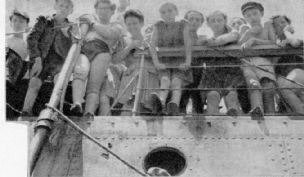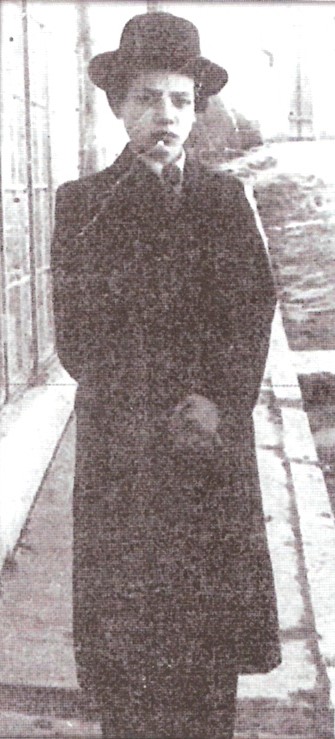80 Years Since the Mefküre Disaster
By: Yaakov Rosenfeld
The Mefküre ship disaster that occurred exactly eighty years ago is an event that the tzaddikim (righteous men) of Vizhnitz often carried in their hearts with sadness and grief.
Mefküre was the rosy hope that crashed in the middle of the sea, and became a black hole in the heart, a hole of longing and burning sadness.
But to begin, the dry historical data of the Mefküre, courtesy of Wikipedia:
The Mefküre was an illegal immigration ship that sailed from Romania to Turkey in August 1944, and was sunk on its way by a submarine. Out of over three hundred passengers, only five survived.
The Mefküre was a two-masted Turkish sailing ship built in 1929, weighing 120 tons. In August 1944, the Mossad Le’Aliyah Bet (agency smuggling Jews into pre-state Israel) organized three vessels to transport Jews from Romania to Turkey. Under Marshal Ion Antonescu, Romania was an ally of Nazi Germany, and the journey from Romania to Turkey was planned with the assumption that the British would allow the passengers to continue on their way to Israel. On August 3rd, 1944, the ships “Morina”, which carried 308 refugees, “Bulbul”, which carried 390 refugees, and “Mefküre”, with more than 300 refugees on board, sailed from the port of Constanta. On August 5th, about forty minutes after midnight, while she was in the western Black Sea near the Turkish port of Igneada, the “Mefküre” was fired at by cannon shells from a submarine, and it sank. The “Bulbul” managed to take five survivors of the “Mefküre” out of the water; Among other things, it was reported that a passenger jumped from the “Bulbul” deck into the water to save passengers from the sea, but most of them drowned. Apart from the passengers, who were mostly Jewish immigrants, there were also five senior officers from the Polish army on the ship, two of whom survived by swimming. One of the officers saved another young woman who fainted, and in addition to these three, a couple named Fullop, who were wearing life belts, were also saved. In addition, six Turkish sailors who jumped into the only lifeboat that was on board the Mefküre were also saved.
Many Jews told how their lives were saved thanks to the fact that they did not board the ship at the last minute, either because they arrived late and were directed to other ships or due to other events such as an illness that prevented them from participating in the trip.
The Night of Shabbat Nachamu (the Shabbat following the fast of Tisha B’Av) 5704/1944
The sea was calm on the night of August 4th, 1944, Shabbat night, the Av 16, 5704. After a day of sailing, the spirit of the war survivors calmed down, and serenity filled their hearts. Many children were in the belly of the ship, but not one of them cried. The babies and children, who had been forced to mature, had already gotten used to the fact that they had no right to cry, for whatever reason… Shabbat Nachamu was that Shabbat, and suddenly, as if out of nowhere, at midnight, bombs fell on the Mefküre and wreaked havoc and destruction on it. Many of the passengers died of burns, and some drowned at sea. Only five managed to survive the Mefküre disaster. Over three hundred Jews plunged into the abyss and their souls blossomed above.

Children on board an illegal immigration ship
According to the testimonies of the survivors, the Germans let dogs loose, which preyed on those who tried to escape by swimming. Terrible cries echoed across the waves, “Yidden, Ratevet!” (Jews, save us!), but there were no chances of being saved. A few managed to hold on to the planks and reach the “Bulbul” – the second ship that miraculously passed by and collected the few who managed to be saved, except for the captain and the infamous Turkish crew members, who forcibly took control of the only lifeboat and saved themselves – only themselves.
The Miracle of Rescue
One Jew, holy and pure, later one of the greatest leaders of charedi (ultra-Orthodox) Judaism, was also supposed to be on the Mefküre, and thanks to his kindness and noble qualities he boarded the Morina and his life was spared. This is the story of the Vizhnitzer Rebbe, Rabbi Moshe Yehoshua Hager z”l, who had a ticket to sail on the Mefküre. A few days before sailing, he was approached by a Jewish woman, the mother of young children whose husband was killed by the Nazis, and was one of the fortunate ones who obtained a ticket for the Morina. The woman was concerned about the education of her children and wanted them to stay near “Erliche Yidden” (G-d fearing Jews) during the days of sailing, and asked the Vizhnitzer Rebbe to change his plans and come with them on the Morina. The Rebbe agreed, and after efforts he managed to get tickets for him and his family for the Morina, and that was his salvation! Later, when she passed away, the Rebbe followed her burial bed and said: “I owe her my life” (she was the wife of Rabbi Lipa Naeh z”l).

The Vizhnitzer Rebbe, Rabbi Moshe Yehoshua Hager, in his youth
The Rebbetzin, May G-d Avenge Her Blood
The Rebbetzin Henia z”l, however – the daughter of the “Ahavat Yisrael” of Vizhnitz, and whose husband, the holy Rebbe, Rabbi Mordechai Shraga of Boyan Czernowitz z”l perished in an epidemic in 5702 (1941-2) in the town of Verkhovka (Transnistria) – a righteous woman with great qualities, with a pure heart and noble character, was indeed on the Mefküre ship. Her holy brothers, righteous Vizhnitzer chassidim, and all the members of her branch of the Vizhnitzer family, for years mourned the tragic death of this righteous women, who meritted to escape the Nazi oppressors, but perished on the way to the land of our forefathers and was not buried.
It is said that when her brother, the Vizhnitzer Rebbe, known as the “Dameshek Eliezer” z”l, was waiting for the family members who had arrived in Israel for Shabbat Mevarchim Elul (the Shabbat before the beginning of the month of Elul) 5704/1944, and saw that everyone had arrived except for his righteous and beloved sister, he came crying and asked, “where did you leave my dear sister Henialeh?”
A Wonderful Girl
Among the Mefküre victims was a pious girl and daughter of holy people, Leah Faiga Kanner, daughter of the Chechower Rebbe z”l, refugees of the Iasi Pogrom. According to the testimony of survivors, at the moment the ship broke up, Leah Faiga cried out in a shrill voice: “Save the Torah!” It was an ancient Torah that her father saved from the city of Iasi and he had asked her to bring it to the Land of Israel.
Leah Faiga was a wonderful girl, modest, righteous, and beloved. She prepared herself for her immigration to the Land of Israel with excitement and anticipation. She sewed special clothes “for the Land of Israel,” and asked her father many times if the clothes were modest enough. He was surprised and asked her: “Why do you ask so much? You are used to sewing for yourself.” The girl replied: “When I, with G-d’s help, reach the Land of Israel, I will recite the ‘Shehechiyanu’ (that You gave us life) blessing on the new garment in the Name and glory of G-d, and I want it to be as kosher and luxurious as possible.” Her righteous parents perpetuated her memory by writing a beautiful Torah as an for the upliftment for her soul (from the words of the Biale Rebbe, Ramat Aharon, issue 449, Be’er BaSadeh Stefenesht).
Publicizing the Miracle
In the booklet “Pirsumei Nisa” (Publicizing the Miracle) in the book Minchat Yitzchak, the Rabbi of Jerusalem, Rabbi Yitzchak Yaakov Weiss z”l, told that he too was supposed to be on this ship’s journey, but due to a “delay,” he did not have time to reach the ship at the appointed time and his soul and the soul of his brother-in-law and only son were spared.
Sources: Aaron Schleicher, HaBoker, September 1949, courtesy of the National Library; Vizhnitz Newsletter “Kesher Eitan”; “Be’er BaSadeh Stefenesht”; Wikipedia












